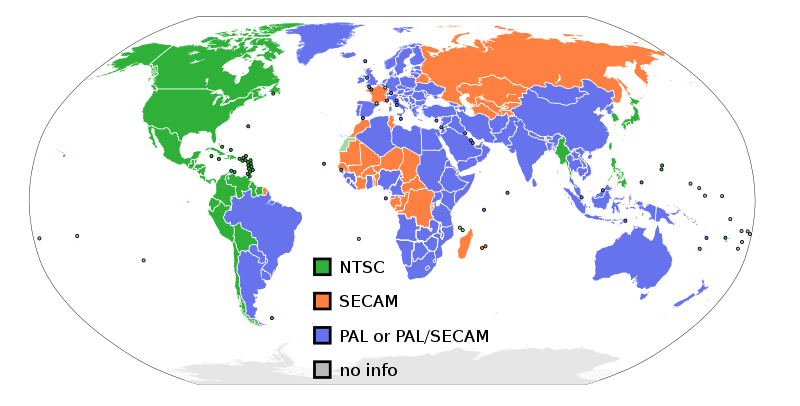NTSC (National Television System Committee)
The NTSC system, also abbreviated as N system, is the color television broadcasting standard established in December 1952 by the National Television System Committee (NTSC). The two main branches are NTSC-J and NTSC-US (also known as NTSC-U/C).
It is a simultaneous system with 60/1.001 fields per second, 525 scanning lines, interlaced scanning, and a horizontal resolution equivalent to 330, with an aspect ratio of 4:3.
The chrominance signal modulation of this standard includes both balanced modulation and orthogonal modulation, resolving the compatibility issue between color and black-and-white television broadcasting but suffering from phase distortion and unstable colors.
Most countries in the Americas, including the United States, Canada, and Mexico, as well as Taiwan, Japan, South Korea, and the Philippines, adopt this standard. Some television companies in Hong Kong also use NTSC broadcasting.
Additionally, some nicknames for NTSC include "Never The Same Color," while PAL is referred to as "Perfect At Last," SECAM as "System Essentially Contrary to American Method," or "Shows Every Color All Murky."
The National Television System Committee was established in 1940 and is under the Federal Communications Commission (FCC) in the United States, aimed at resolving differences in television standards among various companies to unify the national television transmission standard. In March 1941, the committee published technical standards for black-and-white televisions based on a recommendation from the Radio Manufacturers Association in 1936. This standard significantly improved image quality compared to previous standards. The NTSC standard uses 525 scanning lines, which is higher than the 441 lines used by RCA (this standard was already in use on the NBC network at that time). On the other hand, companies like Philco and DuMont intended to increase the scanning lines to between 605 and 800. The NTSC standard also recommends a frame rate of 30 frames per second, with each frame made up of two interlaced scanning lines, and each field containing 262.5 lines, resulting in 60 fields per second. The committee finally recommended a 4:3 aspect ratio and the use of FM modulation for audio (which was a novel technology at the time).
In January 1950, the committee's responsibility shifted to establishing standardized standards for color television. In December 1953, the new television system was directly named after the organization's abbreviation, which is now referred to as the NTSC system (later defined as RS-170A). This color television standard retained compatibility with black-and-white televisions. The color signal was carried in the original black-and-white signal's subcarrier at 4.5X455/572MHz (approximately equal to 3.58MHz). To eliminate image interference caused by color and audio signals, the frame rate was slightly adjusted from 30 frames per second to 29.97 frames per second, and the line frequency was slightly decreased from 15750Hz to 15734.26Hz.
Before the color television standard was unified, American television stations and electronics companies had their own standards. One of these was the standard used by Columbia Broadcasting System (CBS). This standard was not compatible with black-and-white televisions; it used a color rotating wheel. Due to technical limitations, the scanning lines were reduced from the official standard of 525 lines to 405 lines, but the field frequency was significantly increased from 60 frames per second to 144 frames per second (which happened to be an equivalent multiple of 24 frames). In 1951, due to the Korean War, the Office of Defense Mobilization (ODM) restricted broadcasting, indirectly causing various proprietary systems to be abandoned, while RCA successfully continued using its own system until June 1951 due to legal actions. CBS’s proprietary system was also discontinued in March 1953, replaced by the NTSC system from the Federal Communications Commission on December 17 of that year.
The first television program to broadcast using the NTSC color system was the NBC television drama Kukla, Fran and Ollie, aired on August 30, 1953, but it was only viewable within the network's headquarters. The first truly national atmospheric broadcast of an NTSC program was the Tournament of Roses Parade, broadcast on New Year's Day 1954, viewable on experimental television sets at the time.
The first NTSC color television camera was the RCA TK-40 model, which was trial-produced in 1953, with its improved version TK-40A released in March 1954 as the first commercial color television camera. Later that year, the improved TK-41 was introduced, becoming the industry standard camera, still in use by some television stations into the 1960s.
The NTSC color television standard was later adopted by other countries, including many in the Americas and Japan. As digital television broadcasting becomes widespread today, traditional NTSC broadcasting standards are gradually fading into history. Since 2009, television in the United States has fully transitioned to digital broadcasting, and no television programs are broadcast using the NTSC standard.
The following are countries that adopt the NTSC system (in green)

- The above article content is extracted from Wikipedia
Wi-Fi Network Planning Advice
15 Tips for Hard Drive Longevity
10 Things About Image Analysis
知識學院
蘊藏許多助人的知識與智慧。